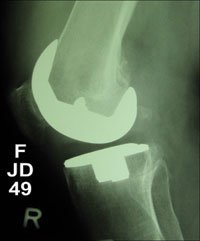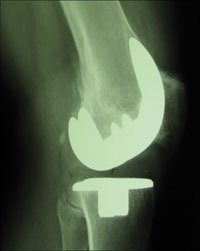Study finds advantages of cementless TKRs over cemented designs
A comparison study of cementless and cemented total knee prostheses revealed no statistical difference in survival curves, infections and other complications, according to a study presented by Venceslav Pisot, MD, at the SICOT XXV Triennial World Congress 2011.
“Trabecular tantalum cementless [prostheses] have advantages of shorter operative time, better biological fixation with consequently potential longevity and avoidance of adverse effect of bone cement,“ Pisot said during his presentation.
For their study, Pisot and colleagues compared 455 cementless procedures performed with the NexGen total knee replacement (Zimmer, Warsaw, Ind.) and trabecular metal monoblock tibial component (Zimmer) to 349 cemented procedures using NexGen High-Flex (Zimmer) replacements. All of the arthroplasties were performed between January 2005 and December 2009. There were twice as many female patients in the study, Pisot said. The average patient body mass index was 31.
Mean follow-up was 3.6 years for the cementless group and 3.3 years for the cemented cohort. During the course of the study, 17 patients died in the cementless group and 18 patients died in the cemented cohort.
|
|
|
|
|
|
|
Pictured are control X-rays of bilateral cementless knee prostheses at 5 months in the right knee (top) and at 5 years in the left knee (bottom). Images: Pisot V |
|
The investigators discovered that the 4-year Kaplan Meyer survival rate was not significantly different between the groups. The survival rate for the cementless group was 97.1% and for the cemented group was 98.1%.
The researchers found that nine total knee arthroplasties (TKAs) in the cementless group were revised vs. eight in the cemented group. In the cementless group, one prosthesis was rigid, one unstable, one malpositioned and one required a patella resurfacing. In the cemented group, three patients needed patella resurfacing, one suffered a periprosthetic fracture and one had a polyethylene insert dislocation.
The cementless group had five infections, while the cemented group had three infections.
“Further investigation and clinical follow-up is warranted,” Pisot said. – by Renee Blisard
Reference:
- Pisot V, Levasic V, Kovac S, Milosev I. Comparison of 4-years survival of cemented and cementless total knee prostheses. Paper #28997. Presented at the SICOT XXV Triennial World Congress 2011. Sept. 6-9. Prague.

- Venceslav Pisot, MD, can be reached at Orthopaedic Hospital Valdoltra, Jadranska c. 31, 6280 Ankaran, Slovenia; 386 05 66 96 100; email: venceslav.pisot@ob-valdoltra.si.














